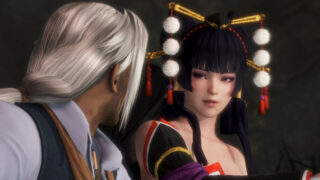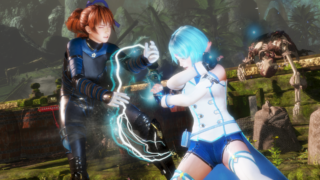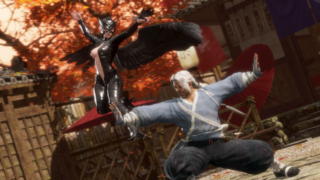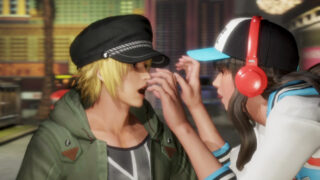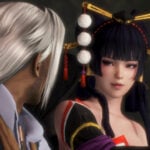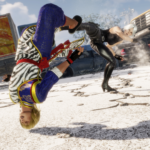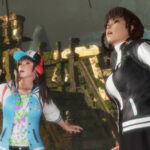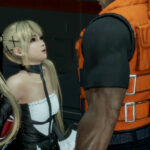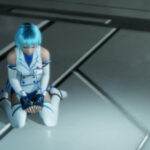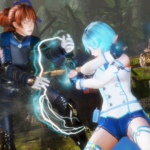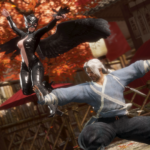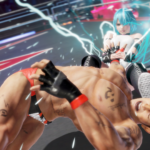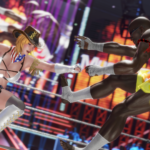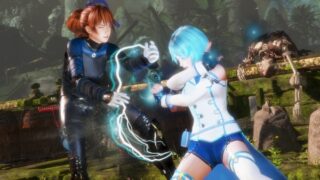
Late last week, I flew to San Francisco to play the final build of Dead or Alive 6 and speak to producer and director Yohei Shimbori.
Find my hands-on impressions and interview below.
Hands-On Impressions
I had the opportunity to play the final build of Dead or Alive 6 for about two hours. In that two hours, I played about 50 matches, or somewhere between 100 and 150 individual fights.
I am not the best at fighting games. For the five or so people that managed to catch my Dragon Ball FighterZ beta live stream way back when that was happening, I am sure you were able to witness this first hand. That being said, Dead or Alive 6 felt pretty good in terms of its accessibility to newcomers like myself.
Since it was the final build, every mode was available to play, but there were limitations on how far I could go. Story Mode was the most difficult to form an opinion on as I was only allowed to play two scenes. Story scenes are set up like a chart, which can be selected and played as you unlock them. Some scenes on the chart are only cut-scenes, such as the opening scene, while others include fights, such as the second scene where Marie Rose spars against Helena Douglas. The chart is presented in 3D, but can be zoomed out and flattened to 2D to get a bird’s eye view of all the available scenes.
I have much clearer impressions of DOA Quest, which is the game’s challenge mode. In DOA Quest, you’re given a list of 96 quests to complete with specific characters. Each quest has a set of three missions ranging from easy to difficult—the easiest being simply clearing the fight. An early medium difficulty mission, for example, would be to “Inflict 50 damage with a single combo,” while a early high difficulty mission would be “Perform a ground attack.” Again, these are the first few missions, which is why they might not sound super difficult. Clearing each mission rewards players in-game currency, and clearing every mission in a single quest unlocks a cosmetic reward.
What I appreciated most about DOA Quest is that while it is marketed as a challenge mode, it felt more like a rewards-based tutorial mode. Whenever you are unable to clear a mission, DOA Quest offers to take you to the proper lesson in the actual Tutorial Mode to learn how to perform the move it requires. Of course, doing it in practice and applying it to a real match are two different things. I had trouble clearing the “Perform a ground attack” mission as it required my opponent to be on the floor when the ground attack lands. While I was able to quickly learn how to do this in Tutorial Mode, my opponent did not necessarily want to stay down and let me hit him in the actual fight. Speaking of Tutorial Mode, it probably impressed me the most simply due to its depth. There are tons of categories and individual lessons that should allow even fighting game novices like myself to learn how to play.
I spent most of my time in the standard Versus Mode trying out all the characters and stages in head-to-head matches against a Koei Tecmo representative (thanks for putting up with me, Eric). Among all the fighters I tried, I have to say I probably mostly enjoyed playing as Nico, the new “Lightning Technomancer” character. She moves quickly and has some pretty cool attacks to boot, many of them lightning and teleportation-based. With every character, special attacks are simple to pull off, as they are tied to the R1 button on PlayStation 4 / RB button on Xbox One, which pressing consecutively allows you to unleash a powerful “Fatal Rush” combo. If your Break Gauge is filled high enough, this can lead into a super attack. This is a great addition for newcomers who may be intimidated by the various button combinations of fighting games, but these combo attacks can also be easily blocked and countered by advanced players.
Like I said, I am not the best at fighting games. Generally when I pick one up, it is to have ready for whenever I have friends over. Dead or Alive 6 seems to fit the bill here, especially due to its newcomer accessibility. While I cannot speak for how it fares compared to previous Dead or Alive titles, I had quite a bit of fun playing this one.
Interview
Thanks for giving us your time, Shimbori-san. I want to start off with censorship, which has been a popular topic lately. Can you say if the content of the game is the same across all three platforms, or if any requirements for one version of the game may have impacted the other versions?
Shimbori: “Every platform has the same exact content. And while this doesn’t have anything to do with censorship, there are some differences between platforms when it comes to things like resolution.”
Cool, so there were no changes made to the game that were required by an outside company?
Shimbori: “Correct.”
In the past, it has been said that Dead or Alive 6 is “toned down” compared to previous entries. In what sense?
Shimbori: “Actually, when we said ‘toned down’ before, it was actually misunderstood, so we’re hoping to avoid using that phrase from now on. Rather than toning it down, it was more of a change in image. Since the main concept of Dead or Alive 6 is intense fighting entertainment, we decided everything from the user interface to the default costumes of the characters to show each character’s fighting style. For example, Hitomi is a karate user, so she wears karate clothes.
“Rather than saying ‘toned down,’ we wanted to create a cooler and more heroic look to the characters themselves. As you can see with Kasumi, it’s only her default costume that has that [covered up] look. When people first saw this, they thought that the entire game would be toned down, but it’s only the default costume. There are some costumes that are more cutesy looking and some that are sexy. So it’s not toned down, it’s just that we based the game on a desire to create this image of intense fighting entertainment.
“Also, Dead or Alive also has male characters, and another thing we wanted to focus on is that there were some new players that might feel embarrassed about playing the game, which we wanted to avoid, which is why we made the default costumes have a cooler and more heroic look to them.”
And just to finalize that topic, what are your personal thoughts on the whole Sony censorship ordeal that has been a hot topic as of late?
Shimbori: “In regards to regulations, it’s not actually just limited to Sony. There has been a worldwide change in views recently. But for this game, we really wanted to focus on the fighting game aspect. The only thing that I regret for Dead or Alive 6 is that since it’s a Japanese game, there are some parts of Japanese culture that recent times have deemed no longer acceptable, so not being able to show that is a bit of a disappointment.”
I see, that’s unfortunate… Moving on from that topic, what did you look at in Dead or Alive 5: Last Round that you felt needed to be improved upon in Dead or Alive 6?
Shimbori: “In Dead or Alive 5: Last Round, the tutorials were massive, which is one of the things I thought needed improvement. Did you like studying when you were a kid?”
Somewhat, yeah.
Shimbori: “Well, the tutorials right now are basically like assignments for players to complete. If you like studying, this might not be so painful to you, but for some people, a massive amount of assignments would be very disappointing. So instead of having only a Tutorial Mode, we also created Quest Mode where players can learn the game. In Quest Mode, instead of just having a full-on tutorial, you can learn the game while playing the game. We give you challenges that you can fulfill for each fight, and as you go down the list, it becomes a lot harder to fulfill those challenges. And also as you go down the list, you can gain some rewards and coins.”
I was actually playing DOA Quest before, and one of the things I really liked was that if you are unable to clear one of the challenges, it offers to take you straight to the tutorial that tells you how to clear it.
Shimbori: “Yeah, that was a great idea that I came up with. (Laughs.) This all actually came into shape because I didn’t like studying.”
(Laughs.) Let’s move on to the character roster. How do you decide which characters to include in the initial roster? Also, a lot of people want to know where Rachel and Momiji are.
Shimbori: “The character roster was selected based on where we were going with the story and narrative, rather than the popularity of the characters. So I’d like to remind everyone that Rachel and Momiji are characters from Ninja Gaiden which, although from the same company, are from a different franchise.”
Yeah, everyone was asking where the Virtua Fighter characters are, too… Anyway, did you ever think about offering costume color customization? Playing through the game earlier, I saw that there are different color variations of specific costumes, but would offering a bit more customization by allowing players to manually change the colors of an outfit ever be an foreseeable option?
Shimbori: “As of right now, we’re only planning for set colors. We want to be able to set colors and hopefully have that full design be liked by the players. I understand that it is easier in terms of development to simply let players choose the color. In that case, we wouldn’t need to design everything. But still, we want to make it a rule to offer the things that we design and have everything set to what we would like to offer. It takes a massive amount of time to decide which colors should be in the selection!”
Every character in the game has their own background. Are there any nationalities that you think lack representation and would like to see appear in the future?
Shimbori: “That’s a difficult question. If I said anything in detail, it might not be a surprise in the future, so I’ll hold my tongue on that. But I would like to consider the selection of nationalities when it needs to come up in the next story.”
A lot of folks were wondering about Tag Mode. I didn’t see one in the build I played earlier, which was final.
Shimbori: “I’m a huge fan of Tag Mode, and I’m sorry to say that it’s not included in this game. The reason behind this, however, is because we ran out of memory on the game itself. And that’s due to the graphical improvements, which consumes a lot of the memory of the game data itself. If the graphics level was the same as the previous game, then we would have added it into the game.”
(At this point, Koei Tecmo’s public relations staff alerted me that I’m running short on time and should get in my last question.) Alright, what can I ask… OK, how are you approaching downloadable content? Is this a Season Pass sort of thing like other fighting games? Are you going to release a million costumes like you have in the past?
Shimbori: “Yes to both of those. But no details have actually been determined yet.”
Thank you for your time, Shimbori-san!
Dead or Alive 6 is due out for PlayStation 4, Xbox One, and PC on March 1.
View a new set of screenshots at the gallery.
